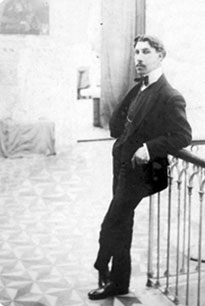Styles
- All Products
- Abstract
- Tapestry
- Constructive Jewels
- Contemporary Art
- Constructivism
- Cubism
- Sculpture
- Expresionism
- Figurative
- Photography
- Geometric Style
- Old Masters
- Hiper-Realism
- Impressionist
- Mural Paint
- Art Belongings
- American Paint
- Contemporary Art
- Foreign Painting
- Folkloric Paint
- National Painting
- Planism
- Realism
- Surrealism
- Torres García School
- Outlet
- Escuela Argentina
- Escuela Chilena
- Expresionismo
- Libros y afiches
- Modernismo
- Neoexpresionismo
- Post impresionismo
- Realismo Social
- ab
- abs
- arteco
- figurativo
- gran
- ob
- pin
- pin
- plan
Herrera, Carlos María
Born on 18th December of 1875, in a family who since Montevideo's Foundation (Uruguay) have long resonance at politics and cultural life of the country. Star his drawing and painting studies -with a clear academic accent- with Pedro Queirolo in Montevideo (Uruguay). Moves to Buenos Aires (Argentina) attending for two years at the Fine Arts Estimulate Circle courses -Artistic education and Institution institución without comparison even our enviroment-.
Proven his painting conditions, obtains a State Schoolarship to improve his studies in Europe. Like others National Artists choosed Rome (Italy) although have two spanish professors residents in Italy: Salvador Sánchez Barbudo and Mariano Barbazán Lagueruela. In 1902 wins a new Schoolarship, this time to study in Spain. There study with Joaquín Sorolla y Bastida. From his return in 1905, begins a continue work stage. Install his art studio in Capurro district, realize more works by order and deploy an intense teaching activity at the recently founded Fine Arts Promotion Circle, where he was teaching director (Uruguay).
Although cultivated the historical gender in his last stage, managed his more high level in the portrait, preferentially feminine and childhood figures. His own family was frequently his model, although was the River Plate high society portrait artist. Herrera utilize the oil but its especially a pastelist. Maked the most of the faint transparence of used material and combine it with his models subtlety. With Carlos Federico Sáenz and Pedro Blanes Viale bellonged by generation at the Modernist Finisecular Painters Group.
Died at 39 years old in 1914, year when the Belle Epoque who portraits as well arrived at his last.

"Carlos María Herrera: A Pastel Master" by Miguel Carbajal.
Carlos María Herrera (1875-1914) pertenece a una familia que llegó al país en 1726, entre las primeraas tandas canarias que arrima Bruno Mauricio de Zabala, y ocupará un claro destino político en las generaciones siguientes.
Carlos María pertenece a la quinta generación y le tocará ocupar en la pintura un lugar de brillo similar al que otro primos suyos, Julio Herrera y Reissig y Ernesto Herrera, ejercieron desde las áreas de la poesía y desde el teatro.
Para algunos, Carlos María Herrera es el retratista uruguayo por excelencia. Como Carlos Federico Sáez, se perfecciona en Italia después de aprendizajes en Montevideo y Buenos Aires. Luego recibe una segunda beca para España.
Su trayectoria curricular exhibe a Sánchez Barbudo en Roma y a Sorolla en Madrid. El trípode se arma con lo que estudió con Sívori en la Argentina. Cuando regresa al país y se instala en él, en 1905, tiene conocimientos y virtudes superiores a los de sus colegas y termina ejerciendo la titularidad del Círculo de Bellas Artes. Lo reconocen sus pares.
Tiene logros insuperables como retratista de damas y niñas; algunos retratos figuran entre las obras maestras del género. Pero además será versátil y se inclinará hacia otros temas. Un viaje a Cerro Largo lo hace descubrir la estética rural y ejecuta pintura gauchesca.
Cuando asume la pintura histórica, con referencias tan ostensibles como las de "Batalla de las Piedras" y "Artigas en la Meseta", completa su espectro plástico. Muere a los treinta y nueve años, en pleno período de madurez.